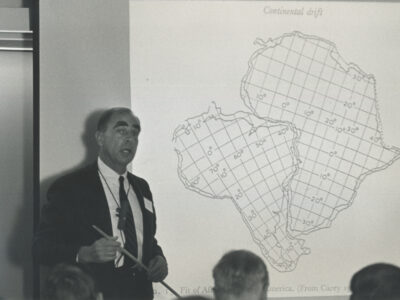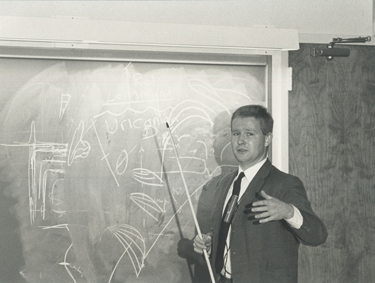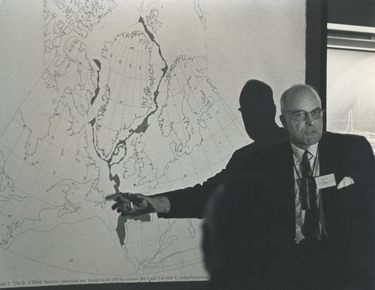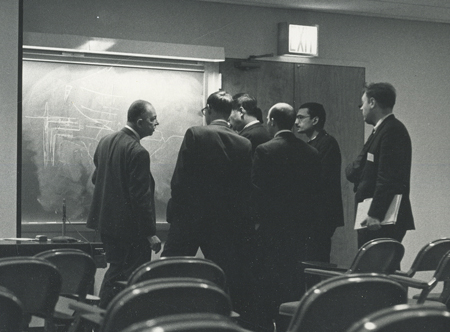Fifty years ago, scientists began to connect details of an idea with profound implications: Earth's ocean crust recycles itself on a global scale, and continents move across the face of the planet.

This week, scientists from across the world are gathered at the American Geophysical Union’s (AGU) Fall Meeting in San Francisco. They attend to be a part of history—at such meetings, those who convene present new results, build collaborations, refine ideas, and engage in discussions that could change the very course of our science.

For those involved with seismology, paleomagnetism, and global tectonics, this year’s event marks an important anniversary of another meeting 50 years ago. On 11–12 November 1966, a crucial meeting took place in New York City at NASA’s Goddard Institute for Space Studies. Called the History of the Earth’s Crust Symposium, the gathering brought together geologists and geophysicists interested in the evolution of continents and oceans, especially in new ideas pertaining to continental drift and the origins and history of the ocean floors.
At the time of the meeting, most geologists believed that the continents and ocean basins were fixed features on Earth’s surface. But at the meeting, separate streams of ongoing research became united, and what emerged was profound and revolutionary in its implications: Earth’s ocean crust recycles itself on a global scale, and continents move across the face the planet.
An Auspicious Time
The History of the Earth’s Crust Symposium occurred at an auspicious time in the geological sciences. New evidence bearing on the evolution of Earth’s crust was just coming to light, from magnetic analysis of surface rocks, sediment cores, and shipboard magnetics data and from seismic data from the world’s oceans. Much of this new information was still unpublished at the time of the meeting.

The meeting was organized by geochemist Paul Gast of the Department of Geology at Columbia University and astronomer Robert Jastrow, director of the Goddard Institute. These organizers realized that new research on geomagnetic reversals, earthquake activity, the nature of the oceanic crust, and the causes of tectonic episodes was coming together in ways that presaged a revolution in the study of Earth’s evolution.
The guest list was impressive and included Harry Hess and Fred Vine of Princeton; Maurice Ewing, Lynn Sykes, James Heirtzler, Xavier Le Pichon, Neil Opdyke, and Walter Pitman from the nearby Lamont Geological Observatory; Henry Menard of the University of California, San Diego; Edward Bullard, John Dewey, and Dan McKenzie from Cambridge; Patrick Hurley of the Massachusetts Institute of Technology; Marshall Kay of Columbia; and other geological luminaries. It marked the first time that geologists and geophysicists came together to focus on what became the new global tectonics [Phinney, 1968].
A Focus on Geomagnetic Reversals
The attendees were particularly interested in new results related to Earth’s magnetism and the subject of geomagnetic reversals. Meeting attendees knew that Earth experienced episodes when the geomagnetic poles flipped, when geomagnetic north became south and south became north.

Prior to the meeting, Allan Cox of Stanford and Richard Doell and Brent Dalrymple of the U.S. Geological Survey in Menlo Park, Calif., had established the timescale of reversals of Earth’s magnetic field for the past few million years [Cox et al., 1964]. They had accomplished this by measuring the magnetic polarities and ages of volcanic rocks from many different oceanic islands and some continental areas.
Their methods will be familiar to anyone who’s worked on paleomagnetism since: They carefully drilled oriented samples from volcanic lava flows and measured their direction of magnetization in the lab. At the same time, they performed radiometric dating of their samples to provide a time history for the magnetic flips they detected. They found that during specific time intervals, paleomagnetic signatures followed the same pattern worldwide.
The internal consistency of the worldwide paleomagnetic and radiometric results established that the polarity events were the result of a rapid switching of the geomagnetic poles and could be correlated from one place to another. Cox, Doell, and Dalrymple brought this new insight to the History of the Earth’s Crust Symposium.
Signatures in Ocean Sediment
Opdyke’s team presented these new results at the symposium. Together, the researchers verified a remarkable result: Ocean sediment cores vertically showed in detail the same sequence of reversals found in the volcanic rocks dated by Cox, Doell, and Dalrymple. The field of magnetostratigraphy was born.
Seafloor Stripes
Also remarkable was the prediction by Fred Vine and Drummond Matthews of Cambridge that because of ongoing seafloor spreading and the reversals of Earth’s magnetic field, the magnetism of the ocean floor rocks should be arranged as a series of stripes of normally and reversely magnetized crust. They proposed that these stripes run parallel to and symmetrical with the mid-ocean ridges [Vine and Matthews, 1963].
The pattern of normal and reversed stripes of ocean floor matched the pattern of geomagnetic reversals found by dating the rocks from continents and oceanic islands and also matched that discovered by Opdyke in his deep-sea cores.
Magic Magnetic Profiles
![(top) Magnetic anomalies, imaged by while traveling across a mid-ocean ridge near Antarctica. (middle) A mirror image of the top profile, reflected across the ridge axis. Note the symmetry in the two profiles. (bottom) A model generated by assuming normal and reversed ocean crust as shown as black and white banded chrons. Credit: Pitman and Heirtzler, [1966]/AAAS](https://eos.org/wp-content/uploads/2016/12/eltanin19-profile.png)
What’s more, Pitman and Heirtzler demonstrated that the patterns of magnetic anomalies could be reproduced by models in which the seafloor was spreading at rates from 1 to a few centimeters per year. They shared their findings at the symposium, and within a few years, scientists were able to use the same techniques to extend the magnetic timescale back more than 70 million years.
Confirmation from Around the World
The confluence of those three lines of research—tracing the Earth’s magnetic reversals in volcanic rocks, in cores of sediment, and on the oceanic crust—transformed geology and geophysics from a collection of unrelated data to a new and dynamic subject. These discoveries represented a paradigm shift in the geosciences.

Independent evidence of seafloor spreading came from measurements of oceanic heat flow by Xavier Le Pichon, who showed excess heating over the ocean ridges, with the crust cooling and subsiding as one moved farther from the ridge crest [Langseth et al., 1966]. Seismological evidence developed by Lynn Sykes at Lamont showed that earthquakes were occurring along the axis of the mid-ocean ridge and on sectors of transverse offsetting faults between the ridge segments [Sykes, 1967]. Using first-motion studies of the earthquakes, Sykes showed that the movement along the faults was not in the direction of the offsets, as might be expected, but the reverse. They were not transcurrent faults but “transform faults” as hypothesized by Wilson[1965] just a year earlier.
Independent geologic evidence of continental drift was also presented at the symposium in the form of Edward Bullard’s computer fit of the continents around the Atlantic Ocean [Bullard et al.,1965], Pat Hurley’s compilation of ancient radiometric age data of the continents from West Africa and South America showing that the patterns matched [Hurley et al., 1967], John Dewey and Marshall Kay’s reconstruction of the Appalachians and Caledonides prior to the origin of the present Atlantic Ocean [Dewey and Kay, 1968], and the presentation of polar wander (now seen as mostly the result of continental drift) by Ted Irving of the University of Leeds and others [Irving, 1964].
A Field Is Born

It is not too rash to say that all of the major players at the conference left the meeting and returned to their respective institutions convinced by the overwhelming evidence that continental drift and seafloor spreading were real. The 2-day meeting in New York City 50 years ago can be pinpointed as the moment when the idea of new global tectonics became a reality.
Now, as we give our talks and present our posters at the Fall Meeting, we can find inspiration in this gathering of scientists half a century ago. We are still feeling the repercussions of that meeting today.
What new fields of research might be born through presentations and scientific discussions this week in San Francisco? We’ll have to wait and see.
Citation: Rampino, M. R. (2016), The meeting that gave birth to the idea of global tectonics, Eos, 97, doi:10.1029/2016EO063933. Published on 12 December 2016.
No comments:
Post a Comment